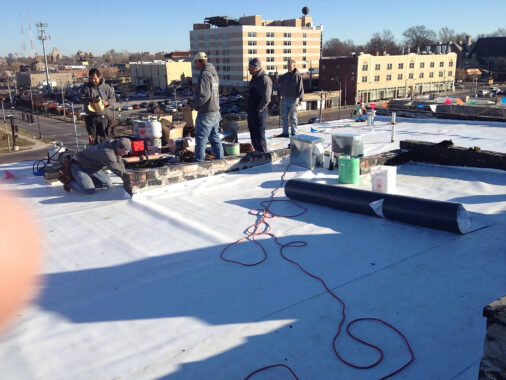Have you ever asked yourself, “What is the difference between TPO and EPDM Single-Ply Membrane Roofing?” To start off, single-ply membranes are sheets of rubber and other synthetics that are chemically adhered to insulation or ballasted. This creates a layer of protection on your commercial building. When thinking about single-ply membrane roofing, there are two types of membranes you can choose from: TPO (thermoplastic polyolefin) and EPDM (ethylene propylene diene monomer). Both types are installed on top of insulation; however, there are slight differences that could affect your building.
TPO Roofing Systems
TPO roofing has been around for about 20 years and is quickly gaining popularity. It is a surface that reflects sunlight and UV rays, which allows commercial air conditioners to perform more efficiently. It also offers lower cooling costs and energy savings for facilities located in warmer climates. Although white is the more common color choice, TPO roofing also comes in gray, tan, and specialty colors. It is not ballasted but it is chemically adhered, the seams are fused with a hot air gun, and can last from 15 to 20 years.
The many advantages that TPO has to offer is what makes it a popular choice among commercial roofing. Besides being energy efficient, TPO roofing has a somewhat higher resistance to punctures, offering about three times more protection against punctures. When there are punctures in your roofing, leaking will occur when rain begins to come down. Another advantage to TPO roofing is that when being installed, they are always welded which makes the system very durable. However, this can also complicate the installation process because welding requires an electrical source. On the same note, any needed repairs for a TPO system are more difficult to implement because electricity will be required to fix the issue.
EPDM Roofing Systems
EPDM roofing systems have been around for about 60 years. It consists of synthetic rubber and is a dark surface that absorbs heat during summer conditions, causing cooling systems to work overtime. EPDM roofing seams are fused together with seam tape and is mechanically attached, can be ballasted, lasts 20 to 25 years, and only available in black.
EPDM is the right choice for you if your commercial building is in an area that usually gets a large number of hailstorms. Due to its synthetic rubber surface, the hail will bounce off with little to no damage to the roof surface or system. If repairs become necessary on an EPDM roofing system, it is easier for a roofing specialist to make the repairs because there is no need for an electrical source for welding. Also, if you are thinking of getting solar panels or your commercial building already has them, then EPDM would be the best choice because it will not interfere with the absorption of sunlight.
Still Undecided?
An investment such as this is a major decision. You want to protect your commercial building as much as possible. Both do an excellent job at protecting your building and what is inside. Your decision could depend on your geographic location, considering heat, hail, and rain, or it could depend on external factors such as whether you plan on mounting solar panels. If you need a professional’s opinion, contact Tesson Roofing & Exteriors at (314) 932-1042. We will be happy to give you an expert recommendation on the best roofing system for your circumstances, as well as answer any questions or concerns you may have.
